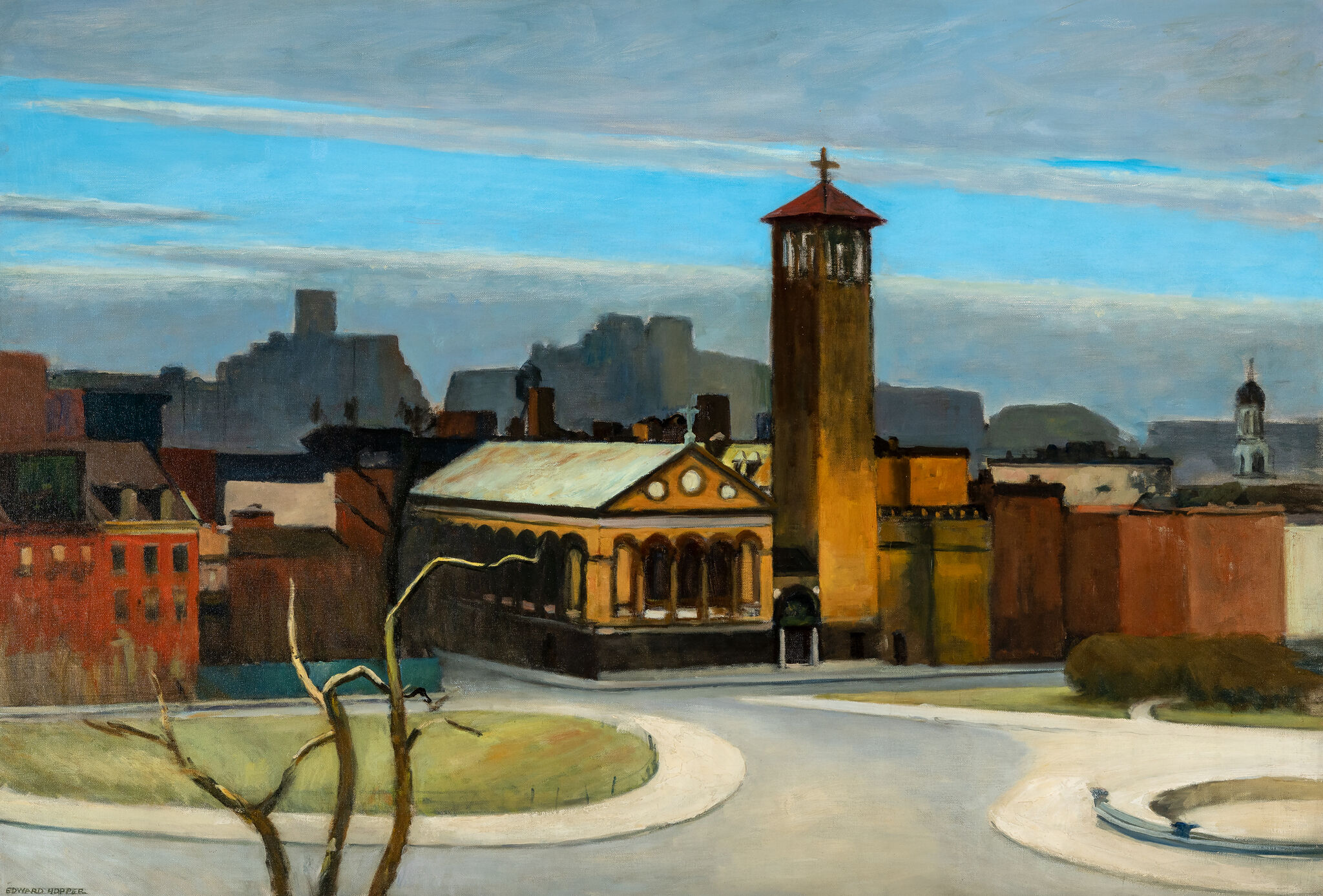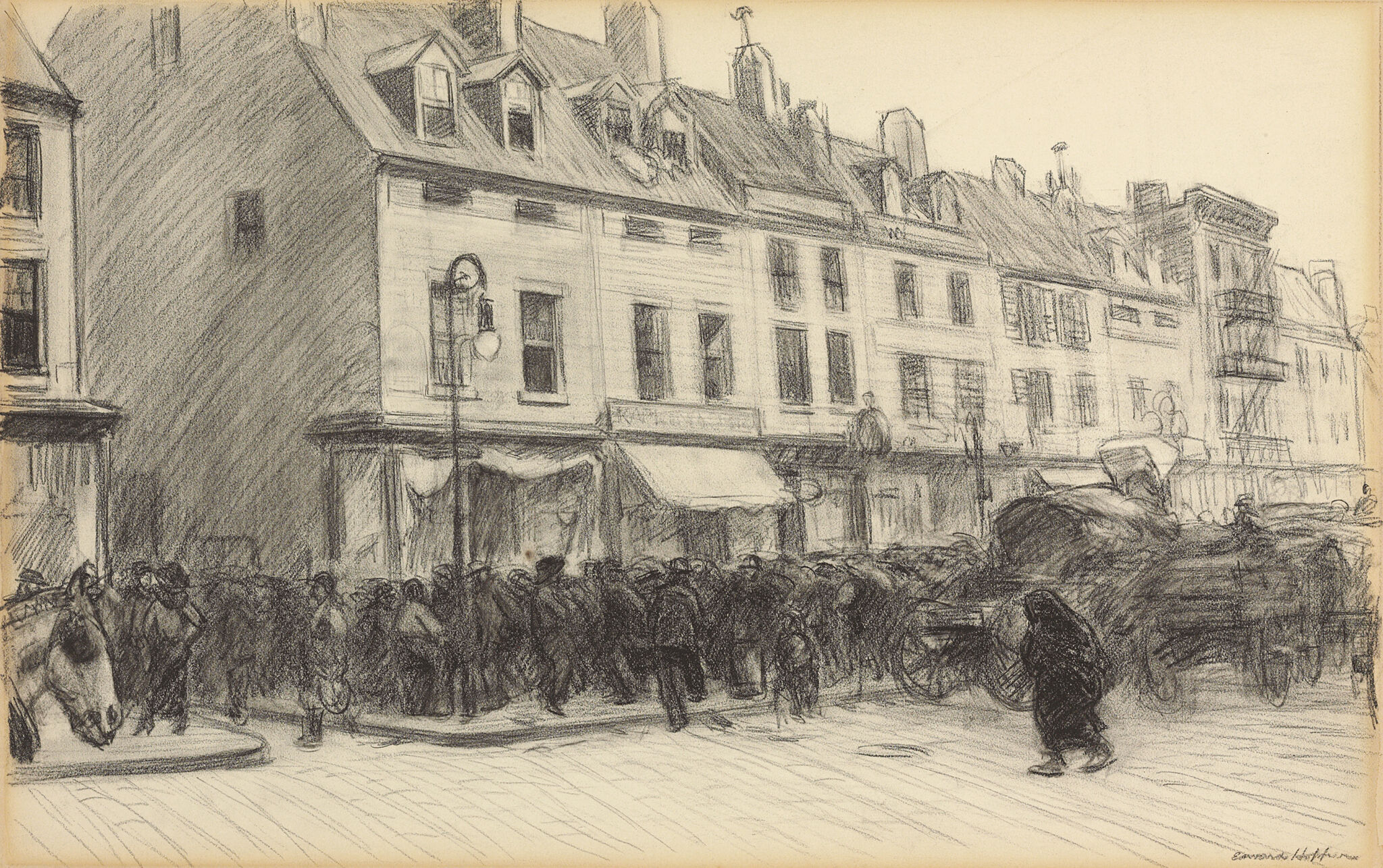Washington Square
“My aim in painting has always been the most exact transcription possible of my most intimate impressions of nature.”
—Edward Hopper
The 3 Washington Square North building was part of a three-and-a-half-story, brick-and-stone Greek Revival terrace built in 1833 that was commonly known as “The Row”. Starting in 1913, Hopper lived and worked there and, with his wife Jo, he remained until his death in 1967. A keen observer of his Greenwich Village neighborhood, buildings, rooftops and park views, Hopper created watercolors, prints, drawings, and paintings inspired by his familiar surroundings. The buildings still stand today on the north side of the park.
In 1932, the Hoppers lived in the front-facing studio-residence on the building’s top floor. It had a broad north-facing skylight, small kitchenette, and shared bathroom. His studio had two long windows overlooking Washington Square Park, a massive easel, and printing press. By the early 1900s, Greenwich Village was a center of artistic life in New York, and yet Hopper sometimes chose to portray it devoid of people or creative activities. November, Washington Square depicts a straightforward autumnal view of the park, the Judson Memorial Church sanctuary building with its ten-story cross topped bell tower, and a group of buildings to the south painted different hues of brown. Hopper left the painting incomplete in 1932, when he stopped making paintings of his neighborhood, just prior to his 1933 retrospective at The Museum of Modern Art. He finished the blue gray sky in 1959, making this work his only double dated painting.
Approximately two years after moving into the back-facing room on the top floor of 3 Washington Square North in September 1913, Hopper created South of Washington Square. The charcoal drawing depicts a catty-cornered view of an ordinary row of nineteenth century buildings with first floor commercial businesses and shops. The streets are teaming with pedestrian traffic and horse drawn carriages. It depicts a familiar Greenwich Village neighborhood scene the artist would have observed. Hopper would often sketch while strolling along the streets near his home, and then exaggerate their features or combine them with details from other sketches in order to create more developed drawings, prints, and paintings.
Activities
How would you precisely depict changing realities?
Hopper’s disdain of the proliferation of abstraction in his day is evident when he expressed, “Painting will have to deal more fully and less obliquely with life and nature’s phenomenon before it can again become great.” Gazing out of his studio windows overlooking Washington Square Park, Hopper faithfully recorded his changing natural environment, whether due to seasonal or manmade causes. Have students select a natural place to study carefully. Invite them to create an artwork that accurately portrays what it looks like today. Then have students do another work at a different time of year, or from a photograph, and compare results.
How can you assert your environmental activism?
In 1936, Hopper wrote the then Parks Commissioner, Robert Moses, to express concerns about the condition of the Washington Square Park’s lawn. By then, fellow neighborhood organizers had campaigned in opposition to Moses’s proposal to ring the park with a one-way circular drive, eventually succeeding in banishing automobile traffic altogether from the park. Hopper also resisted New York University’s expansion efforts, which would have made “use of the park difficult for the public.” Have students think of environmental issues that impact them. Encourage them to devise a campaign that attracts the public’s attention. Their efforts could entail creating posters, writing petitions, Public Service Announcements, etc.
How can you represent the familiar in multiple ways?
Between 1925 and 1928 Hopper made watercolors of the private urban rooftops he viewed from his studio. He also created drawings, prints, and painted works of his Washington Square Park views and local Greenwich Village environs. Discuss with students what surroundings they know well. Have students create several artworks depicting their familiar places. Encourage them to experiment with varied mediums (different types of paint, printmaking, sculpture, collage, photography, video, etc.) for each work. Invite them to explore how the selected medium might affect their depictions. Exhibit and discuss the artworks.
How would you achieve positive change in the face of adversity?
The Hoppers were Washington Square Neighbors organizers who protested landlord New York University’s request to evict tenants from 3 Washington Square North to convert apartments into classrooms. Hopper in an interview argued, “We think it is inhuman and cruel to evict us from here…The University is supposed to be an educational institution, in sympathy with the arts. Is this the way to show it?” Their successful activism included writing letters, circulating petitions, and giving interviews. Discuss with students injustices they can currently identify and actions they can take to rectify them.
Additional Resources
New York University: Information on Edward Hopper’s Studio at 3 Washington Square
Off the Grid: Greenwich Village Society for Historic Preservation blog on the Greenwich Village scenes that inspired Edward Hopper

